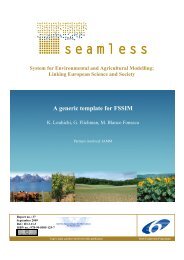Farming Systems Design 2007 - International Environmental ...
Farming Systems Design 2007 - International Environmental ...
Farming Systems Design 2007 - International Environmental ...
Create successful ePaper yourself
Turn your PDF publications into a flip-book with our unique Google optimized e-Paper software.
<strong>Farming</strong> <strong>Systems</strong> <strong>Design</strong> <strong>2007</strong><br />
Field-farm scale design and improvement<br />
greater under zero- than conventional tillage, but for other crops, tillage system had less influence on<br />
productivity than management system or rotation. Ecological management reduced weed biomass at<br />
harvest (Table 2). Wild oat (Avena fatua), green foxtail (Setaria viridis), kochia (Kochia scoparia), and<br />
Russian thistle (Salsola iberica) were the principal weed species present at harvest. Regression<br />
analyses of yield by weed biomass at harvest resulted in highly significant and negative relationships<br />
for wheat and pea, indicating that weed competition had a large impact on grain yield.<br />
Table 1. Mean grain yields from spring wheat, pea and corn, and forage yield from barley<br />
in two management and tillage systems, and four crop rotations, 2005-2006.<br />
Parameter Spring wheat Pea Barley hay Corn<br />
kg ha -1<br />
Tillage system<br />
Conventional tillage 3078 2412 5276 b 3357<br />
Zero tillage 2968 2237 6335 a 3854<br />
Management system<br />
Conventional 3412 a † 2162 b 5149 b 3643<br />
Ecological 2634 b 2489 a 6462 a 3568<br />
Rotation<br />
Continuous SW 2434 b - - -<br />
SW-pea 3167 a 1979 b - -<br />
SW-barley hay-pea 3335 a 2473 a 6133 -<br />
SW-barley hay-corn-pea 3154 a 2522 a 5478 3606<br />
†<br />
Means within columns and parameters followed by different letters differ at P=0.05.<br />
Table 2. Mean weed biomass at harvest from four crops in two management and tillage systems,<br />
and four crop rotations, 2005-2006.<br />
Parameter Spring wheat Pea Barley hay Corn<br />
Weed biomass, kg ha -1<br />
Tillage system<br />
Conventional tillage 240 498 12<br />
Zero tillage 274 733 10<br />
Management system<br />
Conventional 416 a † 729 767 16<br />
Ecological 98 b 502 397 5<br />
Rotation<br />
Continuous SW 547 a - - -<br />
SW-pea 209 b 966 a - -<br />
SW-barley hay-pea 59 b 354 b 367 -<br />
SW-barley hay-corn-pea 213 b 527 b 796 11<br />
† Means within columns and parameters followed by different letters differ at P=0.05.<br />
Conclusions<br />
Early results from this long-term study indicate that ecological management and diversified rotations<br />
improve spring wheat and pea yield, in part through increasing crop competitiveness with weeds.<br />
However, additional research years across a range of environmental conditions are required for<br />
confirmation.<br />
References<br />
Anderson, R., A multi-tactic approach to manage weed population dynamics in crop rotations. 2005. Agron. J.<br />
97, 1579-1583.<br />
Lenssen, A., et al., Cropping sequence and tillage system influences annual crop production and water use in<br />
semiarid Montana, USA, <strong>2007</strong>a. Field Crops Res. 100, 32-43.<br />
Lenssen, A., et al., Diversified cropping systems in semiarid Montana: nitrogen use during drought, <strong>2007</strong>b. Soil<br />
Tillage Res. 94, 362-375.<br />
Sainju, U, et al., Carbon sequestration in dryland soils and plant residue as influenced by crop rotation and<br />
- 36 -




